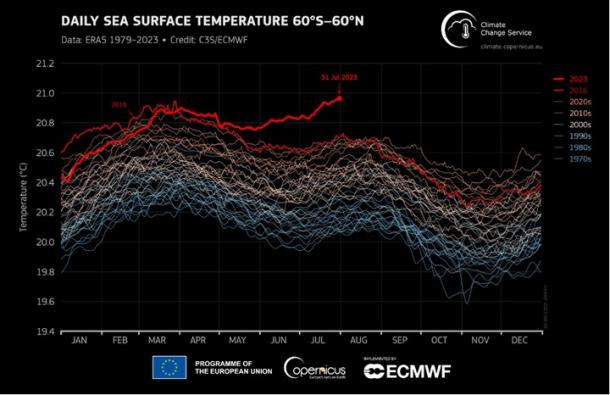July 2023 hottest month ever record: Copernicus

Graphic: Copernicus.
WMO – The global average temperature for July 2023 is confirmed to be the highest on record for any month. The month was 0.72 of a degree Celsius warmer than the 1991 to 2020 average for July, and 0.33 C warmer than the previous warmest month, July 2019.
The Copernicus Climate Change Service (C3S), implemented by the European Centre for Medium-Range Weather Forecasts on behalf of the European Commission with funding from the European Union (EU), routinely publishes monthly climate bulletins reporting on the changes observed in global surface air temperature, sea ice cover and hydrological variables. This month, highlights about sea surface temperature are also included in this press release. All the reported findings are based on computer-generated analyses using billions of measurements from satellites, ships, aircraft and weather stations around the world.
July 2023 is estimated to have been around 1.5 C warmer than the average for 1850 to 1900. Heatwaves were experienced in multiple regions of the Northern Hemisphere, including southern Europe. Well-above average temperatures occurred over several South American countries and around much of Antarctica.
Global average sea surface temperatures continued to rise, after a long period of unusually high temperatures since April 2023, reaching record high levels in July. For the month as a whole, global average sea surface temperatures were 0.51 C above the 1991 to 2020 average.
The North Atlantic was 1.05 C above average in July, as temperatures in the northeastern part of the basin remained above average, and unusually high temperatures developed in the northwestern Atlantic. Marine heatwaves developed south of Greenland and in the Labrador Sea, in the Caribbean basin, and across the Mediterranean Sea. El Niño conditions continued to develop over the equatorial eastern Pacific.
“We just witnessed global air temperatures and global ocean surface temperatures set new all-time records in July. These records have dire consequences for both people and the planet exposed to ever more frequent and intense extreme events,” said Samantha Burgess, Deputy Director of C3S.
“2023 is currently the third warmest year to date at 0.43 C above the recent average, with the average global temperature in July at 1.5 C above preindustrial levels. Even if this is only temporary, it shows the urgency for ambitious efforts to reduce global greenhouse gas emissions, which are the main driver behind these records.”
“News of the warmest month on record perhaps shouldn’t come as a surprise, said Chris Hewitt, Director of Climate Services at the World Meteorological Organization (WMO), during United Nations media briefing on Aug. 8. WMO’s latest annual State of the Climate Report stated that 2015 to 2022 were the eight warmest years on record, and this is on the back of a clear warming decade-on-decade. As we continue to see continued increases in concentrations of greenhouse gases in the atmosphere, this long-term warming will continue and temperature records will continue to be broken.”
Comparing averages for the calendar year to date, from January to July, the global mean for 2023 is the third highest on record, at 0.43 C relative to 1991 to 2020, compared with 0.49 C for 2016 and 0.48 C for 2020. The gap between 2023 and 2016 is expected to narrow in the coming months, as the latter months of 2016 were relatively cool (reducing the annual average to 0.44 C), while the remainder of 2023 is expected to be relatively warm as the current El Niño event develops.
Antarctic sea ice extent continued to break records for the time of year, with a monthly value 15 per cent below average, by far the lowest July extent since satellite observations began. Meanwhile, Arctic sea ice extent was slightly below average, but well above the record minimum from July 2020. While most of the Arctic Ocean saw below-average sea ice concentrations, above-average concentrations prevailed north of the northern Siberian coast.
July 2023 was wetter than average over most of northern Europe as well as part of Ukraine, Russia, North America, Afghanistan, Pakistan, China, Australia, and Chile. Drier-than-average conditions were experienced across the Mediterranean basin, with Italy and southeastern Europe having the largest anomalies. Other drier-than-average regions included Mexico, the southwestern United States, parts of Asia, Australia, southern Brazil and Paraguay.


